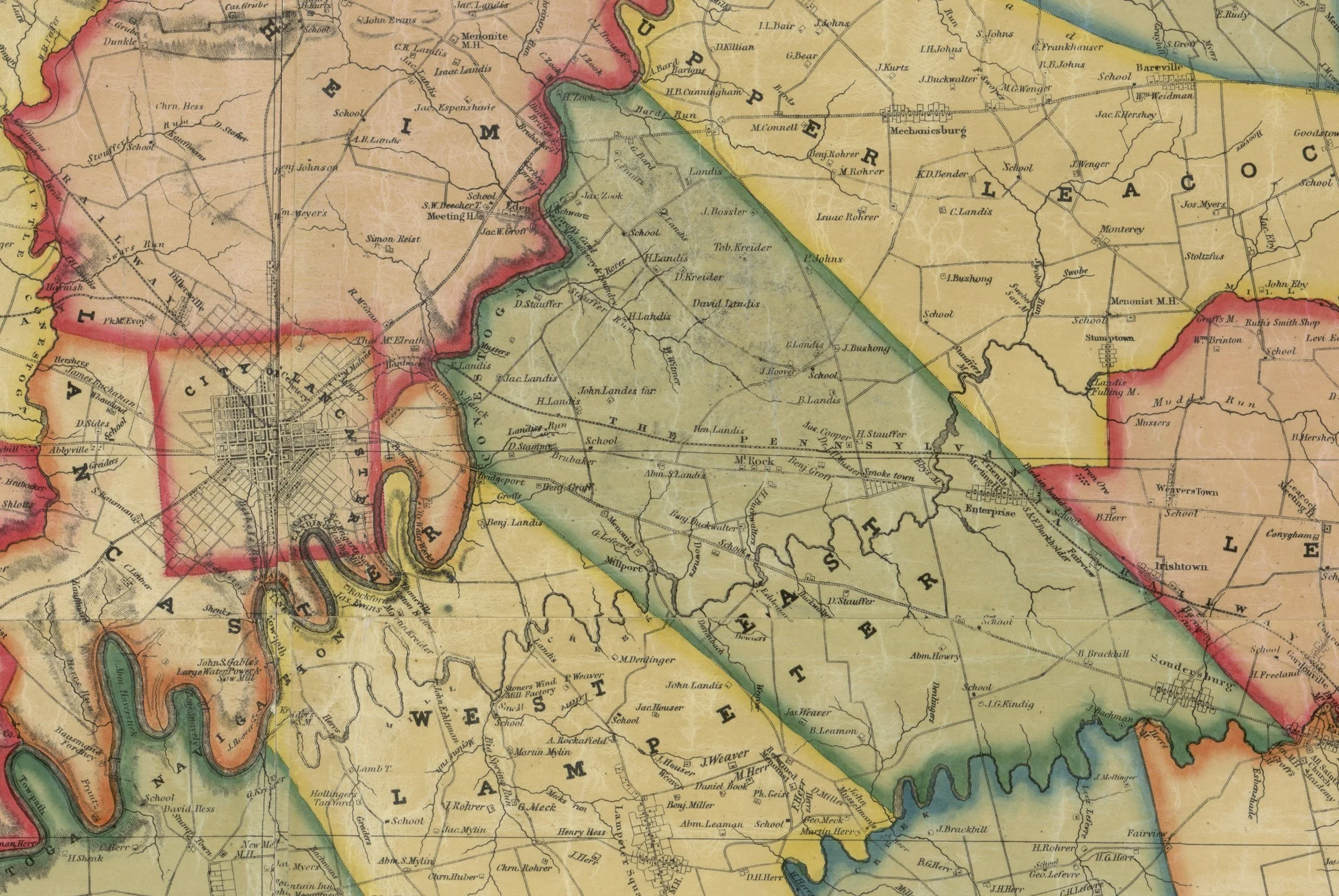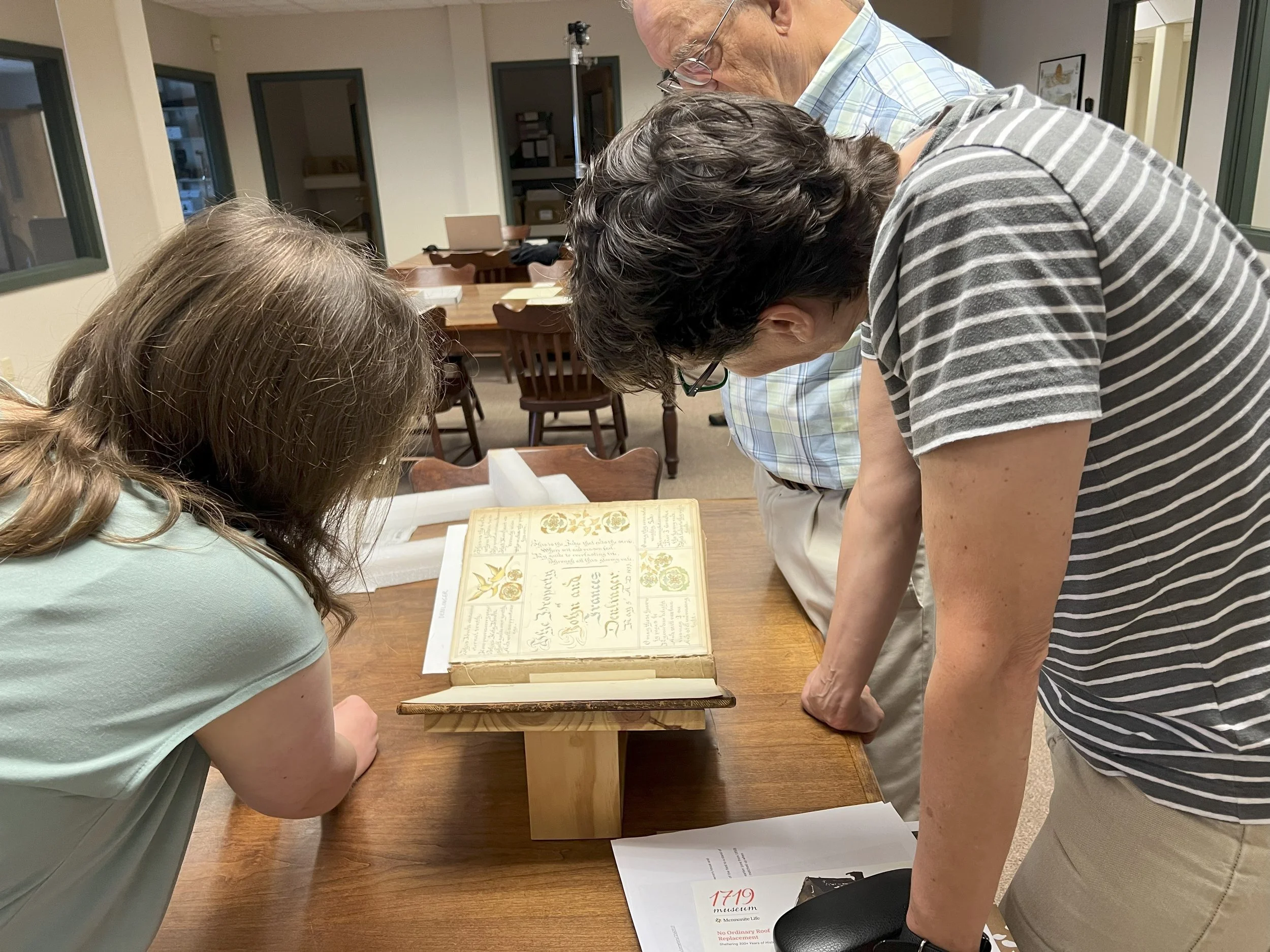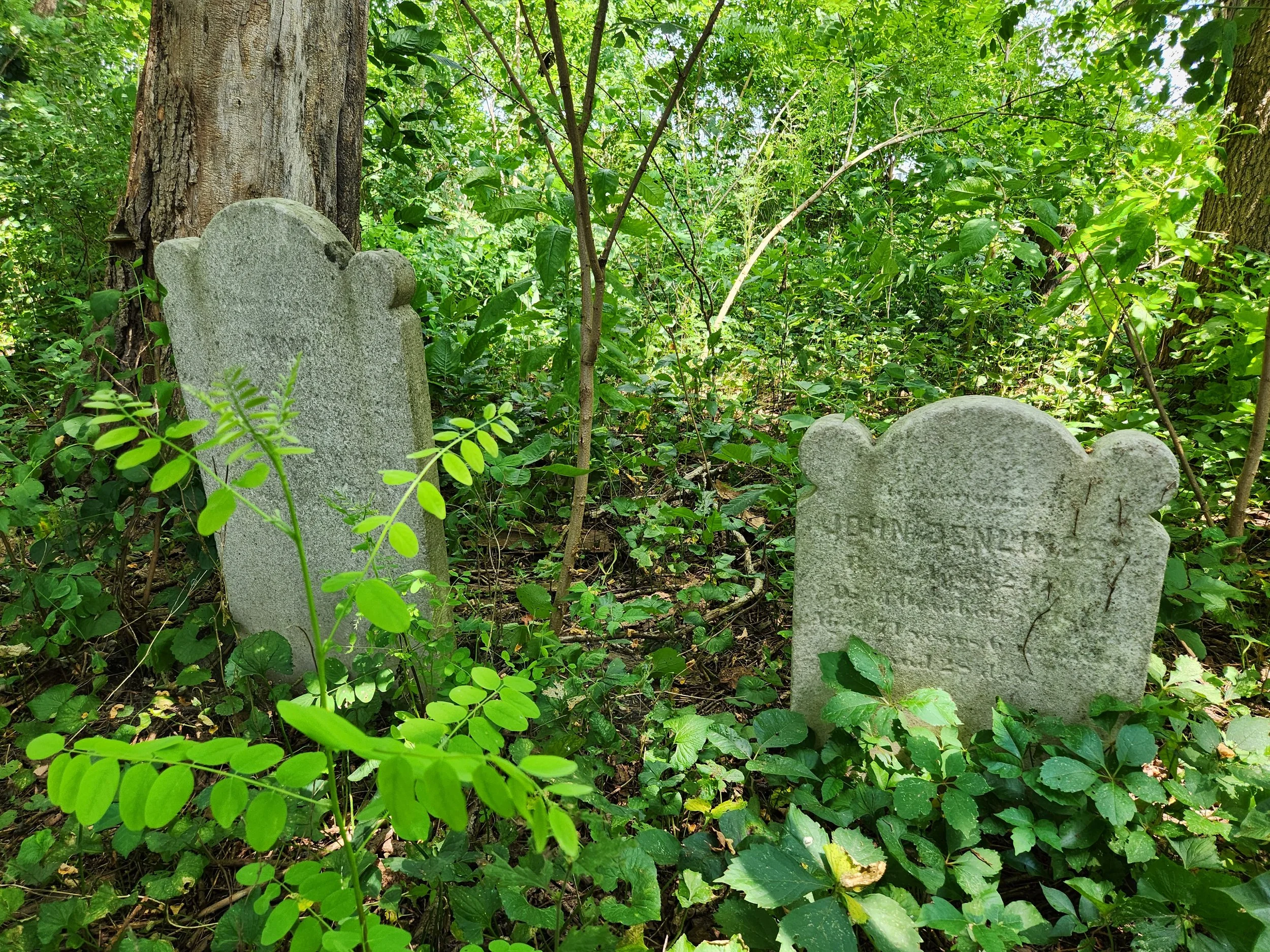““Stories have to be told or they die, and when they die, we can’t remember who we are or why we’re here.””
One gravestone, silhouetted in the sunlight between two trees, invites us into the Denlinger Cemetery
In 1999, my maternal grandfather’s brother, Granduncle Paul Ahlers, wrote a family history that provided details about something my cousins and I heard many times while we were growing up—that we are part “Pennsylvania Dutch.” In his book, Paul includes a copy of “The Denlinger Family,” a well-researched and well-documented article written by distant cousin Ralph E. Denlinger that appeared in Pennsylvania Mennonite Heritage magazine in July 1980. In it, Ralph tells the story of our common ancestor Michael Denlinger, who left with his family from Ibersheim, Germany in about 1715 and came to East Lampeter Township, Lancaster County, Pennsylvania to begin farming on Pequea Creek.
The Denlingers were Mennonites, a branch of the Anabaptist movement originating in Switzerland in 1525. Persecuted for their beliefs by religious and political authorities, Mennonites left Switzerland for other parts of Europe, including the Palatinate region of southwest Germany. Then, according to Encyclopedia Britannica, “Beginning in 1663, Mennonites emigrated to North America to preserve the faith of their fathers, to seek economic opportunity and adventure, and especially to escape European militarism.”[1] The Denlinger family’s arrival in Pennsylvania in 1715 marked the beginning of a four-decades-long “Great Migration” of Palatine Germans to the state.
In his article, Ralph identifies the land on which the Denlinger family settled, including the names of the present-day roads that run through and around it. He also references the Denlinger Cemetery, which was located on the homestead. According to a footnote in the article, “Michael and his wife, Frances, are believed to be resting here in unmarked graves. Their two sons and several other descendants are buried here. The oldest dated stone in the cemetery is 1776.”[2]
According to Ralph, the first three generations of my ancestors stayed in the East Lampeter Township region. A member of the fourth generation, my 4x great-grandfather, moved west to Blair County, Pennsylvania, and several members of the fifth generation “traveled” or moved to Iowa in the 1850s. Ralph’s account matches Paul’s account (and my subsequent research) of the origin of my 3x great-grandfather Christian Denlinger, who came from Pennsylvania to Iowa in 1854, as did two of his brothers around the same time.
East Lampeter Township in an 1851 map of Lancaster County, Pennsylvania
Born in Iowa and never having been to East Lampeter Township, I was eager to explore it. For years I pored over old maps and compared them to current satellite images on Google Maps. I dreamed about driving the roads and seeing the land today. I especially wanted to visit the Denlinger Cemetery. Finally in 2025, the 500th anniversary of Anabaptism and the year of my 60th birthday, I knew it was time! And so my wife and I began to plan a trip.
To prepare, I read Real People: Amish and Mennonites in Lancaster County, Pennsylvania by A. Martha Denlinger. Martha, a member of the Mennonite church, originally wrote the book in 1975 after years of working at the Mennonite Information Center in Lancaster. In it she answers many of the questions that tourists commonly asked her. I researched her background to figure out how she and I are related, and I hoped to meet her. Sadly, she died in 2024, and I would never get the chance.
I also researched the Denlinger Cemetery, which I intended to make the focal point of our trip, and was helped by an information page posted on the Find A Grave website. It alerted me to several facts:
This cemetery is on private property. Before going out to it, stop at the property owner’s house and request permission.
There is no public road access, you have to walk about 120 yards along the edge of the field to a stand of trees in the northeast corner of the property.
Many of the stones are worn/broken.[3]
The website also included a hand-drawn map of the cemetery made by Ralph Denlinger, featuring the location of stones and the list of names and dates carved into them.
We were ready to go!
The John and Frances Denlinger family Bible at the Mennonite Life Archives and Library in Lancaster
I cannot describe how transformative it was to immerse ourselves in that area for just a couple of days. Everywhere there were lush, green farms with fields of tall corn, yards with lines of clothing drying in the sun, and farmstands loaded with everything from tomatoes to honey. From Martha I had learned, “The Amish today and their less conservative neighbors, the Mennonites, often live and work together in the community. But they worship separately.”[4] The Amish farms had carriages parked in their driveways; the Mennonite farms, pickup trucks.
In the restaurants and shops we visited, Amish and Mennonite workers very kindly and peacefully attended their customers, despite the hot temperatures, crowds, and amusement-park vibe of nearby attractions. If we were lucky, we occasionally caught snippets of their conversation among themselves, spoken in Pennsylvania Dutch, a language related to German that has been kept alive since the late 18th century.
We first made our way to the Mennonite Life Archives and Library, where the staff generously pulled a Denlinger family Bible from the shelves and set it on a table for us to view. John Denlinger, who “was born the 5th of January in the year of our Lord 1827, Constellation the Aquarius,” as the Marriages page states, was not an ancestor of mine, but he was a distant cousin. Calligraphy on the title page claimed the Bible as “The Property of John and Frances Denlinger” and was surrounded by colorful illuminations of birds and flowers. Being in the presence of this book connected me directly with these people and this place across centuries, like a hand extended for me to hold for a moment and express my gratitude.
The gravestones of John and Anna Denlinger in the Denlinger Cemetery
And then it was off to the cemetery. We knocked on the door of one farmhouse but found no one home, so left a note of explanation under the windshield wiper of our car and ventured onto a path at the edge of their cornfield. But soon we hit the edge of another cornfield and had to turn around. Driving to a road on the opposite side of the cemetery, we drove up the driveway of another house and found the owner at home. She pointed us to a patch of woods at the end of her lot but said that we might have trouble finding our way because an older man used to take care of the cemetery but hadn’t done so for years. Walking along the edge of another cornfield, we came to a tiny grove of trees, overgrown with shrubs and vines, and with no obvious entryway. Then my wife spotted a gravestone and headed toward it, shouting out to me that there were several more, everywhere! We climbed around in the sweltering heat for about a half an hour, finding one stone after another, and reading their inscriptions. Again, we found no evidence of my direct ancestors, but we knew we were walking on the family’s hallowed ground, and we were so deeply moved. A pilgrimage completed at last.
To others the Denlinger Cemetery may be just a jumbled mix of broken and still-standing gravestones hidden in a tangle of trees and weeds at the far intersection of four cornfields in rural Pennsylvania, but this place felt sacred to me. And as we stood there, I couldn’t help but think: I wouldn’t have known about any of this if someone hadn’t written it down.
Dear descendants of Michael and Frances Denlinger, thank you for carving names and dates on these stones!
Dear John and Frances Denlinger, thank you for keeping a family Bible!
Dear Ralph Denlinger, thank you for writing your magazine article!
Dear Martha Denlinger, thank you for writing your book!
And especially, dear Granduncle Paul Ahlers, thank you for recording our family history in the first place, the original piece that led me on this journey!
I hope that this reflection inspires every reader to begin recording their genealogy. It must be written down, or it will be lost. It is as simple as that. Some people don’t begin writing because they feel like they haven’t completed their research yet. Let me tell you, it will never be done! Start it now, share what you know already. Give others a foothold to take steps from there. Write it down! Write it down! Write it down!
[1] “Mennonite,” Encyclopædia Britannica (https://www.britannica.com)
[2] Ralph E. Denlinger, “The Denlinger Family,” Pennsylvania Mennonite Heritage, Vol. 3, No. 3 (July 1980), p. 12
[3] “Denlinger Cemetery, East Lampeter Township, Lancaster County, Pennsylvania, USA,” Find A Grave (https://www.findagrave.com)
[4] A. Martha Denlinger, Real People: Amish and Mennonites in Lancaster County, Pennsylvania (Scottdale, Pennsylvania: Herald Press, 1993), p. 14
Liz Sonnenberg is staff genealogist for Modern Memoirs, Inc.





